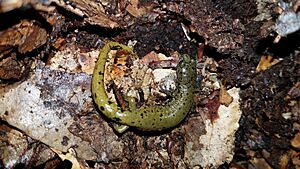Veracruz green salamander facts for kids
Quick facts for kids Veracruz green salamander |
|
|---|---|
 |
|
| Conservation status | |
| Scientific classification |
The Veracruz green salamander (scientific name: Pseudoeurycea lynchi) is a special type of salamander. It belongs to a group of salamanders called Plethodontidae. This amazing creature lives only in a specific part of Mexico. You can find it in the central Sierra Madre Oriental mountains, mainly in the states of Veracruz and Puebla.
Contents
What's in a Name?
The scientific name of this salamander, lynchi, was chosen to honor a scientist named Dr. James Francis Lynch. He was a good friend and worked closely with the people who discovered and named this species. Dr. Lynch lived from 1942 to 1988.
How to Spot a Veracruz Green Salamander
These salamanders have some interesting features that help you identify them.
Size and Shape
Adult male Veracruz green salamanders are usually about 41 to 48 millimeters long. Females are a bit larger, measuring about 41 to 54 millimeters from their snout (nose) to their vent (where waste leaves the body). Their tail is quite strong and gets thinner towards the end. It's usually about the same length as their body. They also have well-developed hands and feet.
Colors and Patterns
The color of their back (called the dorsum) can change a lot. They might be dark green, green-yellow, light yellow-green, or even a blue-gray in some areas. Their main color is black, and they often have many black spots and short lines. The tail is usually lighter than the body and has a bright yellow or reddish-orange tip. Some salamanders even have a light yellow, V-shaped band between their eyes. The parts where their legs connect to their body are often greenish-yellow. Their belly is black, and their eyes have a shiny, coppery-gold color.
Where They Live and How We Can Help Them
The Veracruz green salamander is a terrestrial animal, meaning it lives on land. It also has a special way of growing up called direct development. This means that instead of hatching as tadpoles, their eggs hatch directly into tiny salamanders that look like miniature adults.
Their Home in the Cloud Forest
These salamanders naturally live in cloud forests. These forests are found at high places, usually between 1200 and 1500 meters above sea level. You can often find them hiding in decaying wood, under the bark of fallen logs, under moss, or even under pine logs. Sometimes, they are found off the ground too.
Challenges and Conservation
Even though Veracruz green salamanders can live in forests that are a bit damaged or in rural gardens, they are still in danger. A big problem for them is when their forest homes are destroyed. This happens because of farming, cutting down trees for wood (logging), and mining. Scientists believe that the number of these salamanders is going down. Protecting their forest homes is very important to help them survive.


